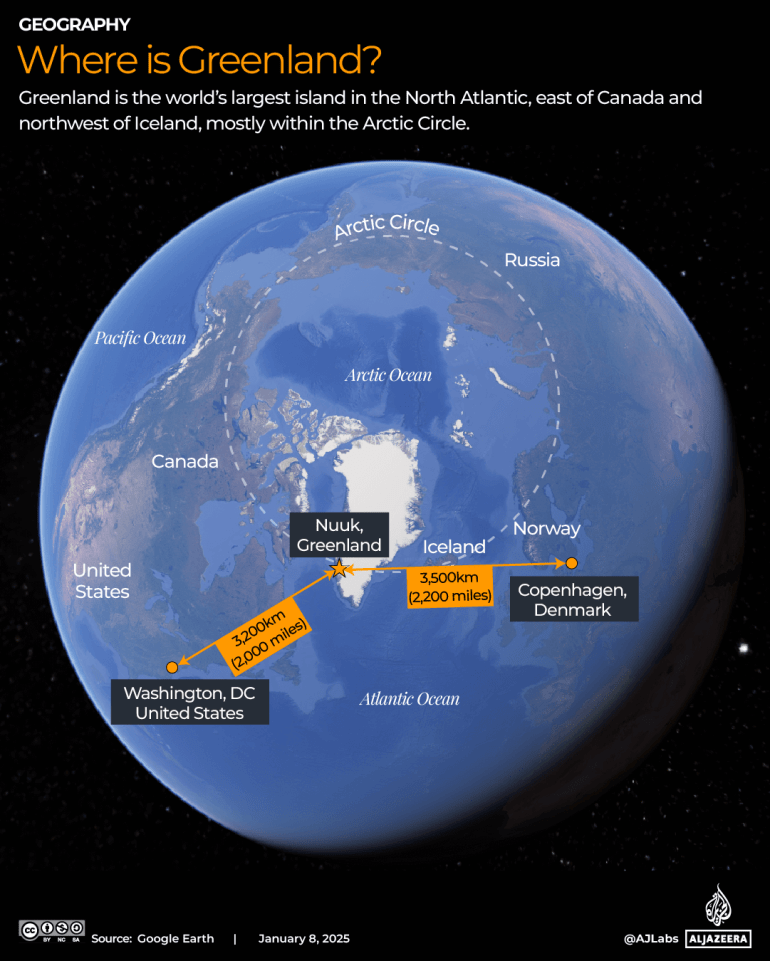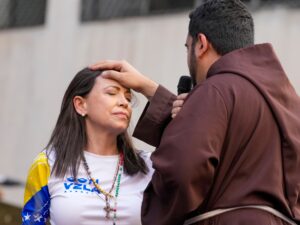At a news conference at his Mar-a-Lago estate in Florida on Tuesday, United States President-elect Donald Trump reiterated his desire to acquire Greenland, which he said was critical to American national security.
The Republican leader, who is set to be inaugurated on January 20, refused to rule out using military or economic power to achieve the goal of taking over the autonomous Danish territory.
Trump has also said he wanted to make Canada the 51st state of the US and seize control of the Panama Canal, as part of his push for US territorial expansion, since winning the elections in November.
So why does Trump want to acquire Greenland — a territory that is 80 percent covered in snow and is more than 3,000km (1,864 miles) from the US capital, Washington, DC? Is it the first time that the US has tried to acquire Greenland?
Where is Greenland? What’s its status?
Located between the Arctic Ocean and the North Atlantic Ocean, Greenland is the world’s largest island and geographically part of North America. Though Australia is much larger and is surrounded by water, it isn’t considered an island because it’s a continent.
Advertisement
Greenland is home to some 56,000 people, mostly Indigenous Inuit people.
Its capital, Nuuk, is closer to New York (some 2,900km or 1,800 miles) than Copenhagen, which is located 3,500km (2,174 miles) to the east.
The island was under Danish rule from the early 18th century until 1979, when it became a self-governing territory. Since 2009, Greenland has the right to declare independence through a referendum.
Greenland’s Prime Minister Mute Egede has called for independence from Denmark.
The Arctic island is one of Denmark’s two autonomous territories, the other one being the Faroe Islands.
Since Denmark is a part of NATO, Greenland is by default a part of the North Atlantic military alliance.
Greenland is not a member state of the European Union, but is associated with it as one of the 25 overseas countries and territories (OCTs) of the EU. “OCT nationals are EU citizens,” an EU law website says. Hence, Greenlanders are considered to be EU citizens.
In 1973, Greenland joined the now-defunct European Community with Denmark, but left in 1985. The EU has replaced the European Community.
The EU has not officially commented on Trump’s recent statements.

How have Greenland and Denmark reacted to Trump’s threats?
On December 23, Trump in a post on his Truth Social media platform said that “the ownership and control of Greenland is an absolute necessity”.
To this, Greenland’s elected Prime Minister Egede said the island was not for sale. “Greenland is ours. We are not for sale and will never be for sale. We must not lose our long struggle for freedom,” Egede said in a written comment.
Advertisement
The Danish government announced it would boost defence spending in Greenland to the tune of $1.5bn following Trump’s desire to take over the autonomous island.
On Tuesday, ahead of his son Donald Trump Jr’s trip to Greenland, the US President-elect again posted on his Truth Social platform saying: “Greenland is an incredible place, and the people will benefit tremendously if, and when, it becomes part of our Nation ….”
Following Trump’s latest comments, Egede met with Danish King Frederik X in Copenhagen on Wednesday, but details of the meeting were not made public.
Danish Prime Minister Mette Frederiksen said on Tuesday that “Greenland belongs to the Greenlanders”, while its Foreign Minister Lars Lokke Rasmussen said that the island had no ambition to become a federal state in the United States.
Why does Trump want Greenland?
This is not the first time Trump has expressed a desire to take control of the island, which hosts a US military base. Trump cancelled his trip to Copenhagen after Denmark, a close US ally, rejected his offer to buy the island during his first term.
Greenland offers the shortest route from North America to Europe. This gives the US a strategic upper-hand for its military and its ballistic missile early-warning system.
The US has expressed interest in expanding its military presence in Greenland by placing radars in the waters connecting Greenland, Iceland and the United Kingdom. These waters are a gateway for Russian and Chinese vessels, which Washington aims to track.
Advertisement
The island is also incredibly rich in minerals, including rare earth minerals used in the manufacture of batteries and high-tech industry.
According to a 2023 survey, 25 of 34 minerals deemed “critical raw materials” by the European Commission were found in Greenland.
Greenland does not carry out the extraction of oil and gas, and its mining sector is opposed by its Indigenous population. The economy of the island is largely reliant on its fishing industry.
Has the US tried to buy Greenland before?
Yes. The US has long expressed an interest in Greenland.
The US has considered purchasing Greenland at least twice, including in 1867 and then in 1946, when President Harry S Truman proposed buying it for $100m. Denmark rejected the offer.
In 1867, the US bought Alaska from Russia. After this, US Secretary of State William H Seward attempted to negotiate the purchase of Greenland from Russia, but the attempt failed.
The US occupied Greenland in 1941 following Nazi Germany’s invasion of Denmark during World War II. It established a military and radio presence in the island and American forces have maintained a permanent presence at Pituffik Space Base, previously known as the Thule Air Base, in Greenland’s northwest ever since.
While Greenland was still a Danish colony in 1946, Truman pitched to buy the island for $100m, an offer Denmark rejected. This was done under Cold War secrecy and was only made public in 1991 in an Associated Press report.
The Mercator projection: How big is Greenland?
Some world maps today can be misleading in terms of how large Greenland actually looks. The Arctic island is 2.17 million square kilometres (836,330 square miles), making it about three times the size of the US state Texas.
Advertisement
However, the Danish territory is perceived to be larger based on maps. This is because modern world maps commonly use a template called the Mercator projection, devised by European cartographer Geert de Kremer in 1569. The projection has been criticised for distorting proportions of landmasses.
On the Mercator map, Greenland territory is shown to be almost as large as Africa. However, in reality, 14 Greenlands can fit inside Africa.

Why did Trump’s son visit Greenland?
Trump’s son Donald Trump Jr arrived in Greenland on Tuesday. The Greenland government said that Trump Jr was visiting the island “as a private individual”, and Greenland’s representatives would not meet him.
Despite this, Trump took to his Truth Social platform on Monday, writing: “I am hearing that the people of Greenland are ‘MAGA’”, referring to the Make America Great Again movement.
“My son, Don Jr, and various representatives, will be traveling there to visit some of the most magnificent areas and sights.
“Greenland is an incredible place, and the people will benefit tremendously if, and when, it becomes part of our nation,” Trump added. “We will protect it, and cherish it, from a very vicious outside world.”
How has the world reacted?
Trump’s recent comments have drawn ire from some European leaders.
German Chancellor Olaf Scholz rebuked Trump’s idea on Wednesday. “Borders must not be moved by force. This principle applies to every country, whether in the East or the West,” he wrote on his X account.
“In talks with our European partners, there is an uneasiness regarding recent statements from the US. It is clear: We must stand together.”
Advertisement
French Foreign Minister Jean-Noel Barrot told national radio on Wednesday that there was “no question of the EU letting other nations in the world, whoever they may be … attack its sovereign borders.”











More Stories
Elon Musk hosts leader of Germany’s far-right AfD on X ahead of election
Venezuela opposition leader arrested a day before Maduro’s inauguration
Is the world at greater risk of more wars?